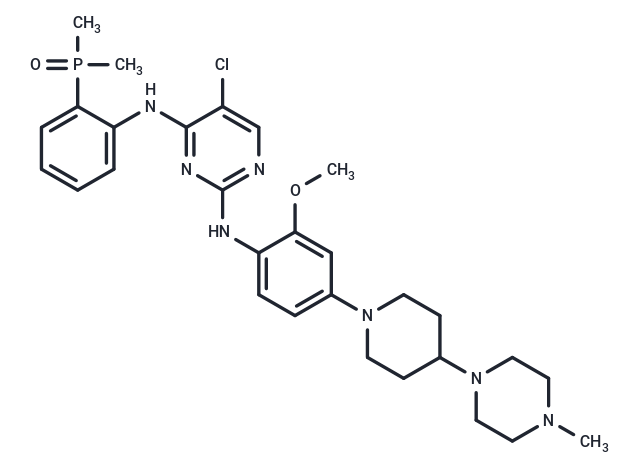Shopping Cart
Remove All Your shopping cart is currently empty
Your shopping cart is currently empty
Brigatinib (AP-26113) is a highly potent and selective inhibitor of ALK.

| Pack Size | Price | USA Warehouse | Global Warehouse | Quantity |
|---|---|---|---|---|
| 2 mg | $30 | In Stock | In Stock | |
| 5 mg | $43 | In Stock | In Stock | |
| 10 mg | $61 | In Stock | In Stock | |
| 25 mg | $88 | In Stock | In Stock | |
| 50 mg | $116 | In Stock | In Stock | |
| 100 mg | $169 | In Stock | In Stock | |
| 200 mg | $253 | In Stock | In Stock | |
| 500 mg | $428 | In Stock | - | |
| 1 mL x 10 mM (in DMSO) | $59 | In Stock | In Stock |
| Description | Brigatinib (AP-26113) is a highly potent and selective inhibitor of ALK. |
| Targets&IC50 | ROS1:1.9 nM, ALK:0.37 nM, FLT3:2.1 nM, IGF-1R:24.9 nM, EGFR (C797S/del19):39.9 nM |
| In vitro | Beyond ALK, IGF1R, and InsR, brigatinib also potently inhibits FLT3 and ROS1 with IC50 values of 2.1 and 1.9 nM, respectively. It does not show significant activity toward c-Met or Ron up to 1 μM[1]. Brigatinib overcomes the resistance of EGFR-triple-mutant and the activity depends on ATP-competitive manner with less affection to wild-type EGFR[2]. |
| In vivo | Mouse PK parameters for Brigatinib following oral dosing (10 mg/kg): Cmax=448 ng/mL,t1/2=5.8 h. And in CD rats, after dosing at 3 mg/kg i.v, CL=0.46 L/(h·kg), t1/2=4.8 h, Vss=7.8 L/kg; Dosed at 10 mg/kg p.o, Cmax=305 ng/mL, tmax=4 h, t1/2=3.4 h, F%=52. Brigatinib demonstrates dose-dependent antitumor activity[1]. Brigatinib demonstrates growth inhibition activity in PC9 triple-mutant xenograft model and in combination with anti-EGFR antibody to potentiate the efficacy both in vitro and in vivo as shown in first-generation EGFR-TKI-resistant patients[2]. |
| Kinase Assay | In vitro HotSpotSM kinase profiling of 289 kinases is performed. The assay is conducted in the presence of 10 μM [33P]-ATP, using brigatinib concentrations ranging from 0.05 nM to 1 μM. |
| Cell Research | All cell lines were used within 20 passages of the initial thaw. Following inhibitor treatment for 72 h, cell growth was assessed to determine the concentration that causes 50% inhibition of cell viability (IC50). (Only for Reference) |
| Synonyms | AP-26113 |
| Molecular Weight | 584.09 |
| Formula | C29H39ClN7O2P |
| Cas No. | 1197953-54-0 |
| Smiles | COc1cc(ccc1Nc1ncc(Cl)c(Nc2ccccc2P(C)(C)=O)n1)N1CCC(CC1)N1CCN(C)CC1 |
| Relative Density. | 1.31 g/cm3 (Predicted) |
| Storage | Powder: -20°C for 3 years | In solvent: -80°C for 1 year | Shipping with blue ice/Shipping at ambient temperature. | ||||||||||||||||||||
| Solubility Information | H2O: Insoluble DMSO: 5.85 mg/mL (10.02 mM), Sonication is recommended. Ethanol: 5.85 mg/mL (10.02 mM), Sonication is recommended. | ||||||||||||||||||||
Solution Preparation Table | |||||||||||||||||||||
DMSO/Ethanol
| |||||||||||||||||||||
| Size | Quantity | Unit Price | Amount | Operation |
|---|

Copyright © 2015-2025 TargetMol Chemicals Inc. All Rights Reserved.